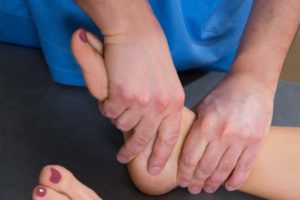What is Foot Mobilisation?
Foot Mobilisation is a hands on, manual therapy that is performed on the foot, ankle and lower leg. The aim of foot mobilisation is to restore normal function to joints specifically to reduce pain. Tightness and restrictions in the soft tissues around the joints are subjected to forceful movement. The intension of this is to loosen tightness in areas of tendons, ligaments or capsules that stop the joint from being able to move freely.
How does Foot Mobilisation Work?
 The therapy is targeted at freeing up restrictions in the joints and improving the range of motion of the joints so the body can function in an optimal state.
The therapy is targeted at freeing up restrictions in the joints and improving the range of motion of the joints so the body can function in an optimal state.
During mobilisation, the joints are moved passively. This means that it is the therapist moving the bones – not your own muscles. Most commonly, one bone coming into a joint will be held steady by one hand. The other hand will test if the opposing bone can move in the way that it should. If the movements can’t be completed normally, the point of restriction will be identified and multiple movements will be performed to get a little more movement with each repetition.
Why might you need foot mobilisation?
As a result of some kind of injury, several things might happen in a foot. For example, a tear to tissue might heal with scarring, making the tissue shorter and tighter. Alternatively, where one part of your foot has pain, other parts may start to work differently to protect the injured area. There is a ‘law’ in physiology that tells us that tissues will always adapt (in this case shorten) to their shortest functional length. If a joint doesn’t move into its complete, normal range of motion for a while, eventually it wont be able to do. This is because the tissues will tighten up to remove all of the unused ‘slack’ from the system. Over time, these patterns can become set with the result that the muscular pulley systems at work in your body can no longer reproduce the movements they once could.
What might you expect from foot mobilisation?
 What we usually find is that most stiff joints will loosen well after a few minutes of movement. These movements are easy to perform and painless when there is nothing wrong. Sometimes, if there is a big problem to be found, the movement of one or more joints can be mildly painful. Freeing these up can be taken slowly. Often, the process is repeated over a number of weeks. We will usually find that the process is easier and more comfortable on each subsequent occasion.
What we usually find is that most stiff joints will loosen well after a few minutes of movement. These movements are easy to perform and painless when there is nothing wrong. Sometimes, if there is a big problem to be found, the movement of one or more joints can be mildly painful. Freeing these up can be taken slowly. Often, the process is repeated over a number of weeks. We will usually find that the process is easier and more comfortable on each subsequent occasion.
The flexibility gained on day one often starts to wane by the end of a week but some of the improvement persists. We build on this over the course of several weeks. Thus, although mobilisation is effective quickly for the right condition, and recipients feel good immediately after the first session, more than one treatment is usually required for optimal results.
What Conditions can Foot Mobilisation be used to treat?
There are many biomechanical problems that can be helped by mobilisation and stretching. These conditions include
- Heel pain
- Ankle pain or restriction
- Achilles’ tendon problems
- Aching balls of feet
- Stiff toes or feet
- Tired, arthritic feet
- Foot cramps
- Sore arches
- Many types of arthritis
- Night pain in feet
- Lateral foot pain (on the little toe side of the middle foot area)
- Pain outside and down from the kneecap
- Constrictions after surgery or injury.
Contraindications to foot mobilisation:
- Laxity in the joints / hypermobility
- Gout
- Infection
- Surgical screws and plates in the immediate area may be an issue.
Age is not an issue, though forces may be reduced in some cases.
What aftercare is required?
As Foot Mobilisation Brisbane treatment is non-invasive, there is no aftercare required. We start the process with a fairly moderate degree of force to assess response before going at things with more gusto. It is not impossible that you might feel a little sore after the treatment. Far more often though, the immediate result is a ‘freeness’ that has been missing since the time of the injury. It is useful to try to apply heat to the area with topical rubs (e.g. Dencorub) or hot water bottle a couple of times over the following days.
How much does foot mobilisation cost?
An assessment of your pain and function will be completed as part of your initial assessment. If mobilisation is the right thing for you, it will often be done at this first visit. The price may vary for repeat visits for a series of treatments. If a wide range of areas need to be done, it will occupy a normal appointment. If only a small area needs attention, it may be possible to schedule these in a 10 – 15 minute appointment at a lower cost. Occassionally we will use mobilisation in concert with other therapies such as soft tissue prolotherapy of the feet.

Recent Comments